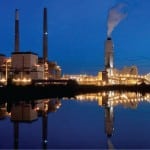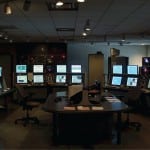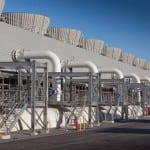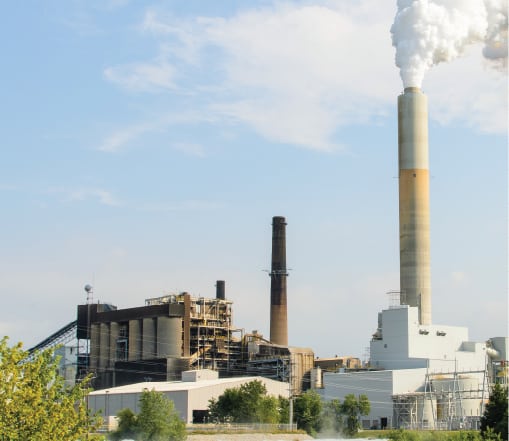 |
To comply with the New Hampshire law governing mercury emissions, Merrimack Station management recently installed a single scrubber system on the facility’s two coal-fired boilers. The plant’s Clean Air Project was completed on Mar. 30, 2012, ahead of schedule and under budget. Now the 440-MW Merrimack Station has reduced its mercury and sulfur dioxide emissions by more than 95% and is one of the cleanest coal-fired power plants in the nation
The 440-MW Merrimack Station is Public Service Co. of New Hampshire’s (PSNH) largest power station. As the PSNH fleet’s workhorse, the facility strives to be a role model in its environmental compliance efforts.
In 2006, the Multiple Pollutant Reduction Program, Mercury Emissions was enacted, requiring mercury emission reductions from existing coal-burning power plants in New Hampshire. The law required PSNH to install wet flue gas desulfurization (FGD) technology at its Merrimack Station. To meet the new law’s July 1, 2013, compliance deadline, PSNH developed its Clean Air Project and began construction in March 2009, Mike Hitchko, PSNH project manager, told POWER in August.
“PSNH’s installation of pollution control equipment at the Merrimack Station has been driven by state initiatives,” Hitchko said. “However, this will serve the station well as emerging federal regulations become obligations.”
Strict Project Management Pays Off
PSNH selected URS Corp. to manage the Clean Air Project. The utility asked URS to develop a realistic and current cost estimate in the early stages of the project. To accomplish this goal, URS issued preliminary specifications to the key bidders (FGD technology, limestone/gypsum storage and handling, chimney equipment, and wastewater treatment system) to seek both technical and price feedback. Hitchko explained that “this effort set the stage well for quality specifications used for the formal bidding effort and greatly contributed to the site-specific project cost development. The initial cost of this project was never increased, and the end value was under budget by 7.6%.”
The project’s initial budget was $457 million, which was based on the site-specific, two-into-one, asymmetrical scrubber to be installed. Hitchko pointed out that the plant had a challenging, tight configuration with numerous constraints and restrictions.
“However, with a fully integrated design, engineering, and construction effort, a reserve was developed beyond contingency funds as a result of strict project and contract management,” Hitchko said. “This resulted in the top line budget estimate being lowered twice—once from $457 million to $430 million with two years to go and the second from $430 million to $422 million with one year to go. Even with unforeseen incremental changes causing unexpected costs, the project was able to absorb these costs and still be under the newest budget projection.”
Clean Air Project Overview
The project team placed the FGD system in service on Sept. 28, 2011 (mechanical completion) when the first unit’s flue gas was processed through the scrubber. The Clean Air Project achieved substantial completion on Mar. 30, 2012. Initial emission performance results indicate a reduction of 97% to 98% for mercury emissions and 96% to 98% for sulfur dioxide emissions. Further testing is planned, including additional performance tests and state testing (Figure 1).
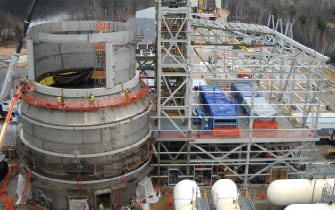 |
| 1. Fighting flue gas pollutants. Management at the 440-MW Merrimack Station recently installed a single scrubber system to cut mercury and sulfur dioxide emissions. The flue gas desulfurization absorber vessel, which is made of alloy 2205 stainless steel, is shown with its flue gas inlet connection. When this photo was taken, the vacuum filters had been set in place and the building’s steel, stair tower, and elevator were being erected. Courtesy: URS |
Major subcontractors for the Clean Air Project were Sterling Boiler (FGD system), Northern Peabody (wastewater treatment system), Merrill Iron & Steel/AZCO (duct and steel components), AZCO (mechanical work), and E.S. Boulos (electrical work).
Other contractors included:
- Engineering and design of secondary wastewater treatment system (WWTS) to eliminate effluent discharge: Burns & McDonnell
- Engineering and design of a potential adjustment protection system to mitigate A2205 absorber vessel corrosion: Sargent & Lundy
- FGD technology and erection: Siemens Environmental
- WWTS, including physical/chemical process with enhanced mercury and arsenic filtration technology: Siemens Water Technology
- Limestone and gypsum handling and storage equipment and erection: Dearborn Mid-West Conveyor
- Chimney equipment and erection: Hamon Custodis
- Distributed control system: Emerson
- Wastewater treatment system, including distillation and evaporation process: Aquatech
Under normal operating conditions, the Merrimack Station employs more than 100 people. This number, however, is supplemented with contractors during planned outages. Hitchko said that nine new positions were added to the station staff due to this Clean Air Project—eight physical worker positions and one engineering position.
Putting Safety First
Working at an operating plant poses numerous safety challenges. Therefore, safety was a priority at the earliest stages of the project. Hitchko explained, “URS effectively incorporated constructability review input and ‘design for safety’ protocol into the design process, helping to contribute to a safe construction site without impacting plant operations. This was especially true for the ductwork and steel erection, where crane access was limited and the weights of duct sections needed to be coordinated with the construction work plan.”
One of the design criteria that resulted from the design review process was the use of walkways on top of all of the ductwork with stair access to all platforms, which provided a safe working environment for plant operations and maintenance personnel. The project achieved over 1.6 million man hours worked without a lost-time accident.
Innovative Design Features
The Clean Air Project included a number of technologies customized for the Merrimack Station.
Two-into-One Absorber. The project configuration includes a single absorber vessel and FGD system to serve the two-unit plant, and each unit operates independently. The boilers are positive pressure, cyclone burner design, built in the 1960s and are not designed to operate with negative pressure excursions. The project required additional new booster fans for each unit with fan discharges tied together in a common plenum leading to the absorber inlet.
Unit 1 incorporated an absorber bypass to atmosphere using an original Unit 2 stack to aid in providing an open flow path for boiler venting and to allow limited single-unit operation independent of FGD system outages. Both units have booster fan recirculation ducts that allow a portion of the flue gas to bypass the absorber vessel when the recirculation dampers are opened, effectively flattening the fan operating curve and assisting with fan control during independent unit startup and low-load operation.
Wastewater Treatment System Design Evolution. The WWTS consists of an innovative physical-chemical treatment system for FGD wastewater, using well-established technology that has the benefit of two decades of worldwide operation. Following the physical-chemical treatment system, the FGD wastewater is directed through a treatment subsystem that is specially designed to address the FGD wastewater generated by Merrimack Station’s FGD system. This enhanced treatment system polishes the treated FGD wastewater to achieve additional removal of mercury, arsenic, and other metals, as well as further reduction in total suspended solids concentrations. Using proven wastewater polishing techniques, this subsystem employs filters and two different types of adsorbent media. This enhanced system was added to meet state effluent limits.
Hitchko explained that due to the U.S. Environmental Protection Agency’s reluctance to provide National Pollutant Discharge Elimination System (NPDES) modifications to accommodate the state-reviewed and approved scrubber liquid effluent, the project team had to add a secondary WWTS to the project scope in early 2011. He said, “This equipment reduces the system effluent to zero and thus does not need any NPDES approvals. The recently issued new draft NPDES permit for Merrimack Station is in a comment/review period, which will extend the date for a final NPDES permit even further into the future.”
Acoustical Modeling Design Impact. In addition to ductwork and limited accessibility issues, the design was further challenged when acoustical modeling resulted in the need to add an acoustical enclosure around the booster fans. Because the enclosure was added subsequent to the fan/ductwork design phase, it created additional design and construction challenges. The large enclosure ensures that the project’s acoustic design goals are achieved and that the project will have negligible acoustic impact on the station’s neighbors.
— Angela Neville, JD is POWER’s senior editor.







